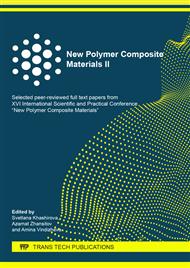[1]
B. Gross, G.M. Sessler, J.E. West, Location of charge centroid in electron beam charged polymer films, Journal of Applied Physics. 48 (1977) 4303-4306.
DOI: 10.1063/1.323419
Google Scholar
[2]
J. Wibbeler, G. Pfeifer, M. Hietschold, Parasitic charging of dielectric surfaces in capacitive microelectromechanical systems (MEMS), Sensors and Actuators A: Physical. 71 (1998) 74-80.
DOI: 10.1016/s0924-4247(98)00155-1
Google Scholar
[3]
W.Q. Li, H.B. Zhang, The positive charging effect of dielectric films irradiated by a focused electron beam, Applied Surface Science. 256 (2010) 3482-3492.
DOI: 10.1016/j.apsusc.2009.12.061
Google Scholar
[4]
H. Von Seggern, Charging dynamics of dielectrics irradiated by low energy electrons, IEEE Transactions on Nuclear Science. 32 (1985) 1503-1511.
DOI: 10.1109/tns.1985.4333643
Google Scholar
[5]
G.M., Sessler, R. Gerhard-Multhaupt, A review of methods for change-or field-distribution studies on radiation-charged dielectric films, Radiation Physics and Chemistry. 23 (1984) 363-370.
DOI: 10.1016/0146-5724(84)90051-7
Google Scholar
[6]
G. Blaise, C. Le Gressus, Charging and flashover induced by surface polarization relaxation process, Journal of Applied Physics. 69 (1991) 6334-6339.
DOI: 10.1063/1.348832
Google Scholar
[7]
R. Garcia-Molina, A. Gras-Marti, A. Howie, R.H. Ritchie, Retardation effects in the interaction of charged particle beams with bounded condensed media, Journal of Physics C: Solid State Physics. 18 (1985) 5335-5345.
DOI: 10.1088/0022-3719/18/27/019
Google Scholar
[8]
J.R. Gerhard-Multhaupt, M. Haardt, W. Eisenmenger, G.M. Sessler, Electric-field profiles in electron-beam-charged polymer electrets, Journal of Physics D: Applied Physics. 16 (1983) 2247.
DOI: 10.1088/0022-3727/16/11/027
Google Scholar
[9]
M.J. Kadhim, S.I. Al-Rubaiey, A.S. Hammood, The influence of laser specific energy on laser sealing of plasma sprayed yttria partially stabilized zirconia coating, Optics and Lasers in Engineering. 51 (2013) 159-166.
DOI: 10.1016/j.optlaseng.2012.08.010
Google Scholar
[10]
N.H. Sabah, K.N. Leibovic, Subthreshold oscillatory responses of the Hodgkin-Huxley cable model for the squid giant axon, Biophysical Journal. 9 (1969) 1206-1222.
DOI: 10.1016/s0006-3495(69)86446-5
Google Scholar
[11]
S. Redman, The attenuation of passively propagating dendritic potentials in a motoneurone cable model, The Journal of Physiology. 234 (1973) 637-664.
DOI: 10.1113/jphysiol.1973.sp010365
Google Scholar
[12]
G.M. Strain, W.H. Brockman, A modified cable model for neuron processes with non-constant diameters, Journal of Theoretical Biology. 51 (1975) 475-494.
DOI: 10.1016/0022-5193(75)90075-2
Google Scholar
[13]
D. Durand, The somatic shunt cable model for neurons, Biophysical Journal. 46 (1984) 645-653.
DOI: 10.1016/s0006-3495(84)84063-1
Google Scholar
[14]
A.K. Schierwagen, A non-uniform equivalent cable model of membrane voltage changes in a passive dendritic tree, Journal of Theoretical Biology. 141 (1989) 159-179.
DOI: 10.1016/s0022-5193(89)80015-3
Google Scholar
[15]
R. Poznanski, A generalized tapering equivalent cable model for dendritic neurons, Bulletin of Mathematical Biology. 53 (1991) 457-467.
DOI: 10.1016/s0092-8240(05)80398-2
Google Scholar
[16]
J.D. Evans, G.C. Kember, G. Major, Techniques for obtaining analytical solutions to the multicylinder somatic shunt cable model for passive neurones, Biophysical Journal. 63 (1992) 350-365.
DOI: 10.1016/s0006-3495(92)81631-4
Google Scholar
[17]
R. Poznanski, Electrophysiology of a leaky cable model for coupled neurons, The ANZIAM Journal. 40 (1998) 59-71.
Google Scholar
[18]
M. Ohme, A. Schierwagen, An equivalent cable model for neuronal trees with active membrane, Biological Cybernetics. 78 (1998) 227-243.
DOI: 10.1007/s004220050429
Google Scholar
[19]
W. Rall, A statistical theory of monosynaptic input-output relations, Journal of Cellular and Comparative Physiology 46 (1955) 373-411.
DOI: 10.1002/jcp.1030460302
Google Scholar
[20]
W. Rall, Experimental monosynaptic input-output relations in the mammalian spinal cord, Journal of Cellular and Comparative Physiology. 46 (1955) 413-437.
DOI: 10.1002/jcp.1030460303
Google Scholar
[21]
W. Rall, Membrane time constant of motoneurons, Science. 126 (1957): 454-458.
Google Scholar
[22]
W. Rall, Branching dendritic trees and motoneuron membrane resistivity, Experimental Neurology. 1 (1959) 491-527.
DOI: 10.1016/0014-4886(59)90046-9
Google Scholar
[23]
W. Rall, Membrane potential transients and membrane time constant of motoneurons, Experimental Neurology. 2 (1960) 503-532.
DOI: 10.1016/0014-4886(60)90029-7
Google Scholar


